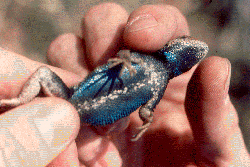An Excursion to Shale Country

fence lizard
My vantage point atop the cliff provided me with an uncommon eye-level view of a turkey vulture lazily circling over Sideling Hill Creek in southeastern Fulton County. As the big bird rocked back and forth on its long wings, I could tell it was an adult due to the late morning sunlight’s illumination of its bright red featherless head. Once again, I was taking an excursion into what I have come to call “shale country” and was standing at the upper limit of a shale barren slope at WPC’s Sideling Hill Creek Barrens Natural Area.
The south-central counties of Pennsylvania include bedrock layers of fine-grained, dark reddish, Devonian Period shales. These have become exposed in places due to the folding of the Appalachian Mountains and the erosive cutting of streams. When the sun heats the dark, south-facing, shale-bearing slopes, it makes this habitat a sort of open eastern desert. Certain plants and animals have adapted to survive here, while others cannot. In fact, a plant found on some of these barrens is the prickly-pear cactus. Because such hot shale slopes are unique and localized, some of the species are rare or endangered. This barren has several, which provided the impetus for WPC’s protection. From here, I can see into Maryland, which, along with the Virginias, is the range for Appalachian shale barrens.
It is late April, so the leaves of the surrounding trees are just expanding, and the canopy is quite open. Looking down the valley and into the forest, I note the hazy bright pinkness of redbuds, a small understory tree that is abundant in the shale-derived soils of this region. Earlier today, I saw clusters of the distinctive bird’s-foot violet adorning road banks. Its purple, lavender and orange flowers are another reason for my seasonal visits, as are the rare Olympia marble and orange-tip butterflies, which I expect to see later.
As I take a step onto some loose shale, my eye catches the motion of another species of barrens habitat. A large fence lizard scurries to the base of a red-cedar tree and I am wagering that it’s a male. It starts to climb the right side of the trunk, disappears to the far side and then peers out from the left to see if I am dangerous. I decide to use the old “hand-is-faster-than-the-lizard” trick, and approach. The lizard climbs high enough to feel that one last scamper will put it out of reach. Eye-to-eye with me now, I put out my left hand and wiggle a finger. I can see its beady little eyeball shift to look there. By the time my right hand swiftly but gently juts around from the back side of the trunk, it is over; I win. As I turn its shale-colored body belly up, the reptile fills up with air, hoping he won’t fit in my mouth. I can say “he” now, as the shocking iridescent royal blue, adjacent to patches of coal black and as striking as of the wildflowers I will see today, are telltale marks. I put the little fellow back on his tree and he ascends.
With the sun a little higher now, I decided to go off and look for a hog-nose snake. Ah, finding one of those beauties would nicely top off another wonderful spring morning in shale country.
Charles Bier is the senior conservation scientist for the Western Pennsylvania Conservancy.
To hear an audio version of Charles Bier’s Field Notes visit iTunes to download free podcasts of his personal accounts and observations of Western Pennsylvania’s natural environment.
